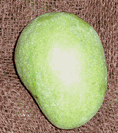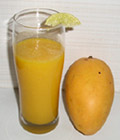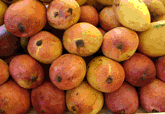اسے فارسی میں آنبہ اور انگریزی میں مینگو کہتے ہیں۔
ایک مشہور اور عام پھل ہے۔ اس کے درخت کو باغوں کی صورت میں لگایا جاتا ہے۔ اس کے باغ بہت طویل و عریض ہوتے ہیں۔ دراصل آم نہ صرف من بھاتا پھل ہے بلکہ ملک کی بہت بڑی دولت ہے۔ آم اور اس کے مرکبات دیگر ممالک کو بھی بھیجے جاتے ہیں۔ آم کی دو بڑی اقسام ہیں۔
1۔ دیسی آم
2۔ قلمی آم
پھر ان کی بیشمار اقسام ہیں۔ قلمی بہت پسند کیا جاتا ہے۔ قلمی میں ذیل کی قسمیں پائی جاتی ہیں۔
لنگڑا، دوسہری، سفیدہ، انوررٹول اور سہارنپوری وغیرہ۔ یہ سب بے حد لذیذ اور شیریں ہوتے ہیں۔
آم موسم گرما کا امرت پھل ہے۔ اس کا شیریں رس واقعی آب حیات ہے۔ اپنی طاقت اور غذائی اجزا کی وجہ سے تمام پھلوں کا بادشاہ ہے۔ لیکن اپنے علاقے سے اس کثرت سے پیدا ہوتا ہے کہ غریب سے غریب بھی پیٹ بھر کر کھاتا ہے۔ بلکہ بعض مقامات پر خود رو ہی پیدا ہوجاتا ہے۔ ایسے آم کو رانی آم کہتے ہیں۔ اس کا ذائقہ دل پسند ہوتا ہے۔ لطف کی بات یہ ہے کہ ہر ذائقہ کا آم مل جاتا ہے۔ تیز میٹھا، معتدل میٹھا ، تیز میٹھا، ہلکا ترش، کھٹ میٹھا، انتہائی ترش او ران سب کے بین بین بھی ذائقہ مل جاتے ہیں۔ عام طور پر پختہ پھل میٹھا اور خام ترش ہوتا ہے۔
درخت آم
آم کا درخت بہت بڑا ہوتا ہے۔ اور سدا بہار درخت ہے۔ تمام سال سرسبز رہتا ہے اس کے پھل کے علاوہ اس درخت کے تمام اجزاء ادویہ میں مستعمل ہیں۔ آم کی چھال پتے ، پھل و گٹھلی اور گوند وغیرہ سب اپنی اپنی جگہ مفید ہیں۔





